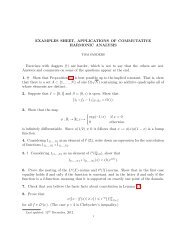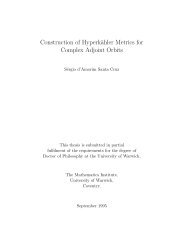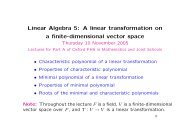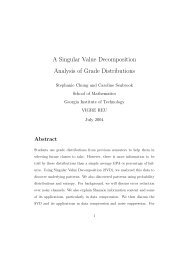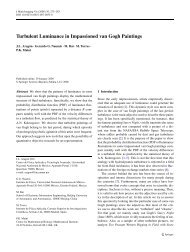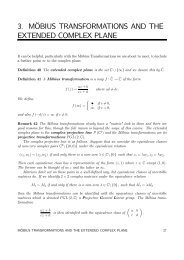Fourier Series and Partial Differential Equations Lecture Notes
Fourier Series and Partial Differential Equations Lecture Notes
Fourier Series and Partial Differential Equations Lecture Notes
Create successful ePaper yourself
Turn your PDF publications into a flip-book with our unique Google optimized e-Paper software.
Chapter 3. The heat equation 32<br />
3.7 Other boundary conditions<br />
Other boundary conditions are possible, e.g. at an end which is thermally insulated the<br />
heat flux is zero. Thus −κTx = 0 there <strong>and</strong>, therefore, Tx = 0. If both ends are thermally<br />
insulated we look for separable solutions of the heat equation of the form<br />
T(x,t) = F(x)G(t), (3.68)<br />
where F ′ (0) = F ′ (L) = 0. We find that F ′′ = −λ 2 F, G ′ = −λ 2 κG, <strong>and</strong> F = acos(λx),<br />
where sin(λL) = 0 <strong>and</strong> so L is one of the numbers {nπ/L : n = 0,1,2,3,...}. The<br />
separable solutions in these circumstances are<br />
a0 <strong>and</strong> ancos<br />
Thus if we consider the IBVP<br />
with boundary conditions<br />
<strong>and</strong> initial condition<br />
we look for a solution<br />
nπx<br />
L<br />
<br />
e −n2 π 2 κt/L 2<br />
(n = 1,2,3,...). (3.69)<br />
∂T<br />
∂t = κ∂2 T<br />
∂x2, 0 < x < L, t > 0, (3.70)<br />
∂T ∂T<br />
(0,t) = 0 <strong>and</strong> (L,t) = 0 for t > 0, (3.71)<br />
∂x ∂x<br />
T(x,t) = 1<br />
2 a0 +<br />
T(x,0) = f(x) for 0 ≤ x ≤ L, (3.72)<br />
∞<br />
ancos<br />
n=1<br />
where the prescribed f(x) has the <strong>Fourier</strong> cosine expansion<br />
The required coefficients are<br />
Note that, as t → ∞,<br />
f(x) = 1<br />
2 a0 +<br />
0<br />
n=1<br />
<br />
nπx<br />
<br />
e<br />
L<br />
−n2π2κt/L2 , (3.73)<br />
∞ <br />
nπx<br />
<br />
ancos , 0 ≤ x ≤ L. (3.74)<br />
L<br />
an = 2<br />
L <br />
nπx<br />
<br />
f(x)cos dx (n = 0,1,2,3,...). (3.75)<br />
L L<br />
T(x,t) → 1<br />
2 a0 = 1<br />
L<br />
L<br />
f(s)ds, (3.76)<br />
theextreme right-h<strong>and</strong>sidebeingthemean initial temperature. Theuniquenessof T(x,t),<br />
for a given f(x), can be established much as before.<br />
0




